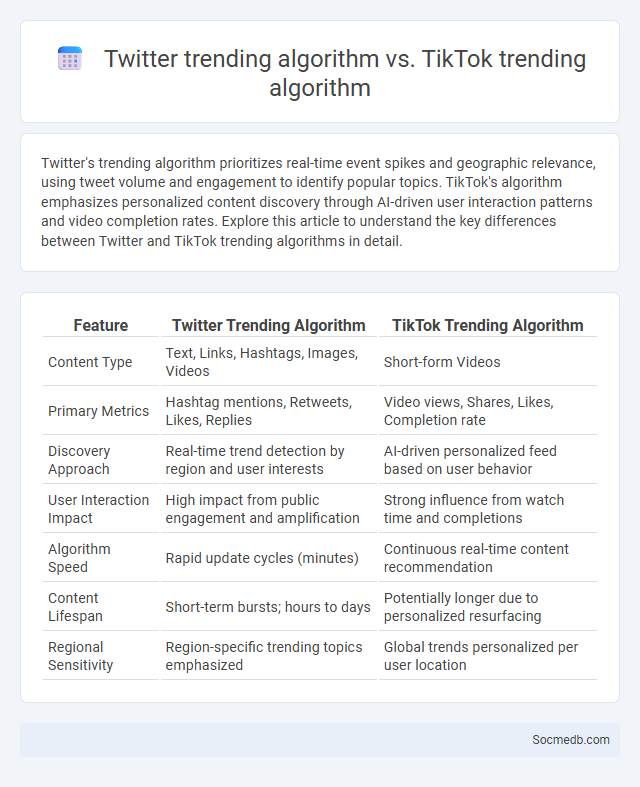
Photo illustration: Twitter trending algorithm vs TikTok trending algorithm
Twitter's trending algorithm prioritizes real-time event spikes and geographic relevance, using tweet volume and engagement to identify popular topics. TikTok's algorithm emphasizes personalized content discovery through AI-driven user interaction patterns and video completion rates. Explore this article to understand the key differences between Twitter and TikTok trending algorithms in detail.
Table of Comparison
| Feature | Twitter Trending Algorithm | TikTok Trending Algorithm |
|---|---|---|
| Content Type | Text, Links, Hashtags, Images, Videos | Short-form Videos |
| Primary Metrics | Hashtag mentions, Retweets, Likes, Replies | Video views, Shares, Likes, Completion rate |
| Discovery Approach | Real-time trend detection by region and user interests | AI-driven personalized feed based on user behavior |
| User Interaction Impact | High impact from public engagement and amplification | Strong influence from watch time and completions |
| Algorithm Speed | Rapid update cycles (minutes) | Continuous real-time content recommendation |
| Content Lifespan | Short-term bursts; hours to days | Potentially longer due to personalized resurfacing |
| Regional Sensitivity | Region-specific trending topics emphasized | Global trends personalized per user location |
Overview of Trending Algorithms
Trending algorithms on social media platforms prioritize content based on user engagement metrics such as likes, shares, comments, and viewing time, ensuring the most relevant and popular posts gain visibility. These algorithms continuously adapt by analyzing your interaction patterns, preferences, and behaviors to deliver personalized content that maximizes your experience. Machine learning models, including natural language processing and computer vision, are integral in detecting emerging trends and filtering spam, further refining content recommendations.
How Twitter's Trending Algorithm Works
Twitter's trending algorithm identifies popular topics by analyzing tweet volume, engagement metrics, and user location in real-time. It filters spam and repetitive content to ensure the trends reflect genuine conversations and viral events. Understanding how Twitter's system curates these trends can help you leverage timely topics for enhanced visibility and engagement.
How TikTok's Trending Algorithm Operates
TikTok's trending algorithm prioritizes user engagement signals such as watch time, likes, comments, and shares to determine video popularity. It analyzes individual user behavior and preferences through machine learning to deliver personalized content on the For You Page. The algorithm also factors in video information like captions, hashtags, and sounds to categorize and promote trending content efficiently.
Key Differences: Twitter vs TikTok Algorithms
Twitter's algorithm prioritizes real-time content, emphasizing retweets, replies, and likes to promote trending topics and news updates. TikTok's algorithm leverages user interaction patterns such as watch time, video completion rates, and content preferences to deliver highly personalized video feeds on the For You page. While Twitter emphasizes chronological relevance and social connections, TikTok focuses on content engagement and interest-based recommendations.
Common Features in Trending Algorithms
Social media trending algorithms commonly analyze user engagement metrics such as likes, shares, comments, and watch time to determine content visibility. They prioritize personalized content delivery by leveraging your interaction history and preferences to enhance relevance. Real-time data processing enables these algorithms to rapidly identify and promote viral topics, maximizing audience reach and retention.
Factors Influencing Trends on Twitter
User engagement, trending hashtags, and real-time events significantly influence trends on Twitter, driving viral content and shaping public discourse. The platform's algorithm prioritizes tweets with high interaction rates, such as likes, retweets, and comments, amplifying their visibility. Influencers and news organizations also play a crucial role by initiating and sustaining trends through widespread reach and authority.
Factors Driving Trends on TikTok
Trending content on TikTok is driven by user engagement metrics such as shares, likes, and comments, which elevate video visibility through the platform's algorithm. The use of popular hashtags and viral audio clips enhances discoverability, linking content to broader trend networks. Creator consistency and authenticity also play crucial roles in capturing audience attention and sustaining trend momentum.
Impact of Trending Algorithms on Viral Content
Trending algorithms on social media platforms significantly influence the visibility and spread of viral content by prioritizing engagement metrics such as shares, likes, and comments. These algorithms amplify content that quickly gains traction, often shaping public discourse and consumer behavior by promoting popular topics and influencers. The dynamic nature of algorithm updates continually reshapes content strategies, making adaptability crucial for creators aiming to maximize reach and impact.
User Engagement: Twitter vs TikTok Trends
Twitter's user engagement is driven by real-time news, trending hashtags, and conversational threads, making it a platform where users actively participate in discussions and share diverse viewpoints. TikTok's engagement thrives on short-form video content with algorithmically curated personalized feeds, encouraging creative expression and viral challenges that prompt frequent interaction. Both platforms show distinct engagement patterns, with Twitter focusing on text-based interaction and TikTok leveraging dynamic multimedia content to capture user attention.
Future Trends in Social Media Algorithms
Future trends in social media algorithms emphasize greater personalization through artificial intelligence and machine learning, enabling platforms to deliver highly relevant content based on user behavior and preferences. Innovations in natural language processing and computer vision enhance content understanding, improving the accuracy of recommendations and moderation. Privacy-focused algorithm designs will gain prominence as users demand more control over data, influencing platform transparency and trust.
 socmedb.com
socmedb.com